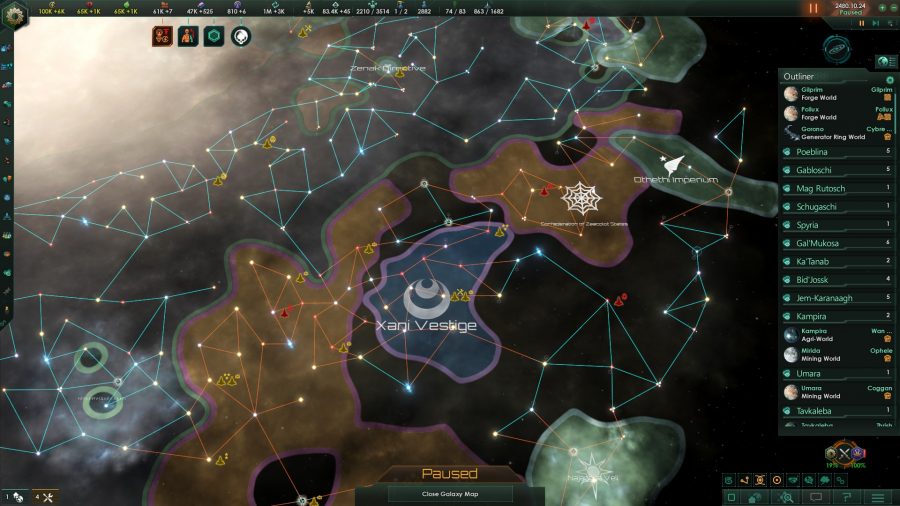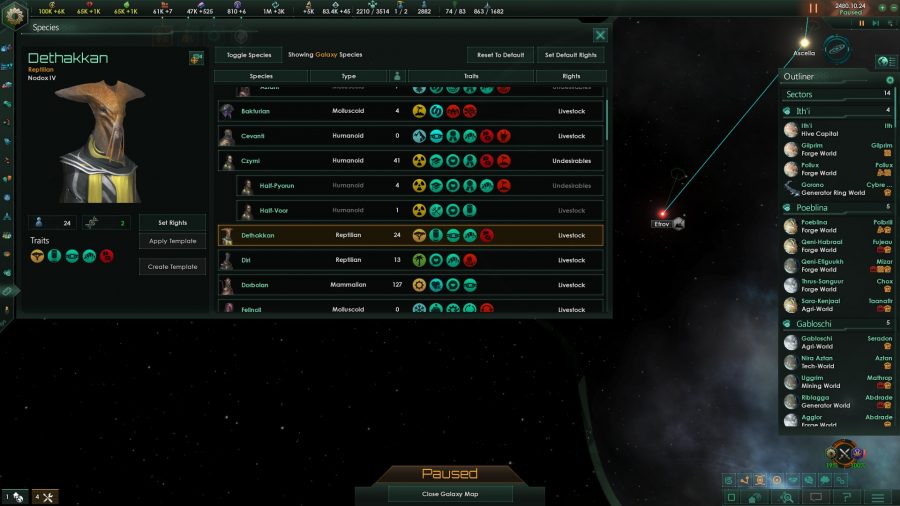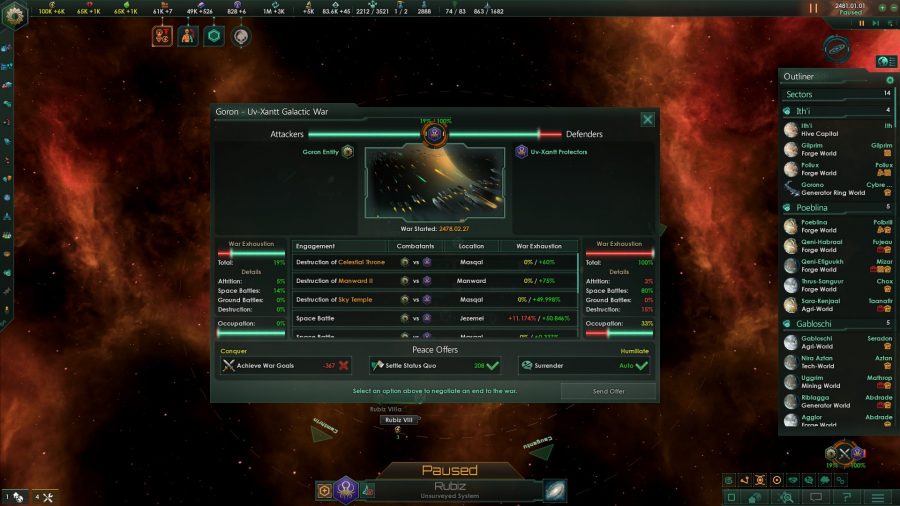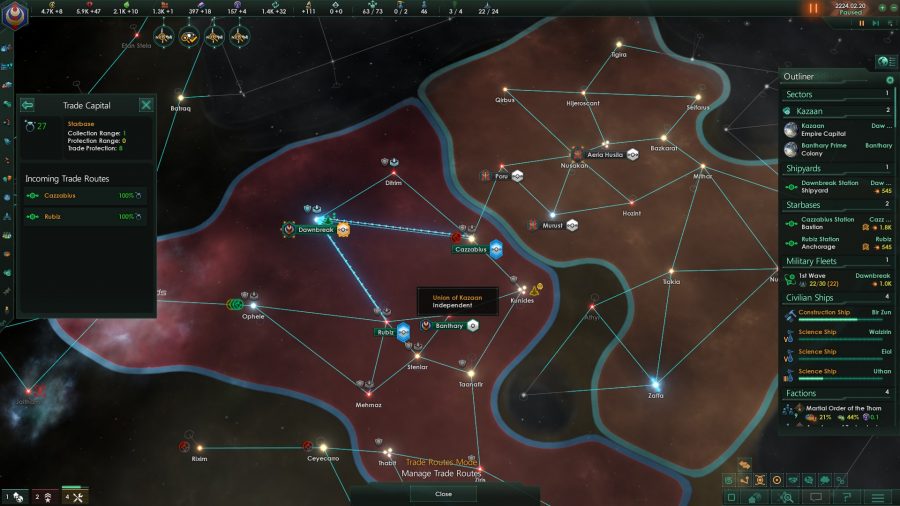Stellaris builds on Paradox’s rich architecture of emergent gameplay, with a dozen pieces of mechanics whizzing by your head while you try to keep an eye on events and control the pulse of what’s going on. Building your first Habitat? Taking down your first Leviathan? Balancing the resource budget as you roll out to war? These are big deals, and space – as Douglas Adams wrote – is a big place. Here are our Stellaris tips to help you out.
This article is mainly aimed at newcomers, or at least past players returning after a long break, but hopefully even veteran players will be able to glean some insights that will help them in the wars to come.
All information is correct as of Version 2.8. We’ve just had some new changes drop, but these basics will still apply. Below, you’ll find tips for managing your economy, planets, your pops, trading and an introduction to diplomacy and ship design. There’s also specific tips for some of the unique empires, such as Hiveminds – everything you need to level-up your skills and conquer the galaxy.
While the bulk of the guide concerns theory crafting, here are some specific tips that should help kick-start your game.
Build a third Science Ship
Since the release of Ancient Relics, it’s become important to have more than two Science Ships at a time. If you’re able to, build a second ship as early as you can afford to with a Scientist with it.
The addition of Archaeology makes it valuable to have at least a third ship available. Its job would be to focus on archaeological digs. Digs take a significant amount of time to go through all of their stages, and can have impactful results at the end of it. The chance of getting a powerful Artifact with a great passive effect early in the game is easily worth the cost of the ship and Scientist.
Once complete, the ship can continue surveying systems, with the possibility of finding even more archeological sites, and starting the whole process again.
Upgrade buildings often
This is both a positive and negative. On the positive side, you have more jobs available for a growing population (unless you’ve taken steps to reduce the growth of the population). On the negative side, each of those jobs when taken consumes more of whatever resource it’s converting. It’s very easy to lose track of where you are on the production curve and start converting entirely too much of something like civilian goods into research, because once you are out of one of those resources — everything that follows it in the production chain stops being produced.
The galactic market is your friend
You will often find yourself working at a deficit. This is not a failure on your part; quite the opposite. If you are growing, production will lag as jobs get taken by your population. Some of the jobs which consume resources will come online before those which produce them. This is the real reason that you want to be running a surplus most of the time. But when that’s not possible remember that you can always buy from the galactic market. That also means that you should always try to keep a positive energy generation up to your maximum storage. Energy buys alloys, alloys become ships. Energy buys food, food feeds a growing population.
Whatever you may be struggling with, the galactic market will give you a way to plug the gaps in your industry until you can fix it.
Early colonisation options
Colonising a planet with the machines only takes 400 alloys. If you construct an alloy processor early along with the mining district to support it, you can be sitting on a comfortable store by the time you’re ready to colonise your first planet. Take advantage of that fact when you can.
Migration treaties
Migration treaties with friendly neighbours can see great surges in your production. Migrant workers from neighbouring Empires can be put to work on agricultural districts, generator banks, and mining facilities. Even if they may not be a perfect environmental match, they’ll much prefer it to starving in the freezing rain on their home worlds.
It’s rare that any company will completely rework the foundations of a game to such a degree. But Paradox is a rare company. They are continually adding content to their game which enables unique and interesting ways to play. They’ve opened the door to the wider Stellaris mod community which allows for a greater diversity of building types, government types, and population traits.
Exploration
Exploring during the early game is key. You always want to try and search out for all important resources. As soon as you can afford it, build a secondary science vessel to send out in the galaxy. Preferably going in the opposite direction to your first science ship, set them a course to survey each system that’s nearby. What this does is reveal potential resources, anomalies and habitable planets that are within a few jumps of your starting system. What this also does is make each system open for your other units to move into. See a system that has decent resources, or even a habitable planet? Once you’ve finished surveying it you can send your construction ship to begin building a starbase outpost in that system. Once done, those precious resources are now available for use.
Resources
Your primary concerns are minerals, power and food. On top of that are alloys and consumer goods. Both of these mid tier resources are manufactured using minerals in specialist buildings known as Alloy Foundries and Civilian Industries. Advanced strategic resources appear very rarely in space-borne areas like asteroids, gas planets, or locations created by special event chains. Like standard strategic resources, they require you to finish special research to make use of them. Living metal, dark matter, and nanites will be familiar to players from previous versions of the game but some of their uses have changed.
Understanding Pops
Pops are life. While they’re not a resource in a traditional sense, Pops are required to fill jobs in your buildings. They generate basic resources and can turn those resources you found into useful things for your Empire. Consequently, Pops should actually be counted as one of your most important resources. Not just used as a workforce, they also affect how big your fleet can be, your starbase capacity, among other things.
Most Empires have populations which fall into three strata:
- Rulers who are at the top of the social pyramid. Responsible for organisation and leadership, rulers generally create Unity and Amenities, which keeps people happy.
- Workers generally work in the district jobs; mining, farming, and in the generator facilities. They make up the vast bulk of your population.
- Specialists fall between the two. An example of a Specialist worker are the Metallurgists working the Alloy Foundry, turning minerals into alloys for your Empire. Or Entertainers who work in Holo-Theatres, generating Unity.
Without the necessities of food, housing, consumer goods/amenities for your population, you’ll begin to brew unhappiness. Unhappiness is a killer. It feeds directly into the calculation the game makes when deciding on a planet’s stability. Highly stable planets function efficiently, and will output resources at a normal rate. Low stability however will place a penalty on anything generated on the planet, as well as increasing random events such as riots and rebellions which will seriously harm your growing Empire.
Certain types of government and Traditions can affect how your Empire deals with, and helps mitigate, unhappiness. An Authoritarian government will focus more on the higher strata and make sure their needs are met, whereas an Egalitarian government takes ‘a needs of the many’ approach to things.
Related: Check out all of the Stellaris DLC that’s available
Crime is also a factor which will play in the development of your planet; too high and you’re losing out on your economy. Consider creating buildings which increase the police presence on your planet. This can be enhanced and exploited by the presence of criminal corporations (though only if you have the Stellaris DLC called MegaCorp). High crime lowers stability, which leads to inefficiency. They are also prone to criminal syndicates setting up on your planets to take advantage and earn money at a penalty to you.
Keeping the districts and buildings balanced with the amount of housing and the number of jobs against the total population of the planet is very much a minigame unto itself. When there are too many pops for the housing or for jobs, the planet experiences emigration pressure and people will tend to move away to other planets which have open housing or too many jobs for their population, or to other empires entirely if you have migration treaties.
Likewise, if a planet has plenty of housing and plenty of jobs which remain unfilled, immigration pressure will tend to draw pops from overpopulated, high unemployment worlds. Along with planetary decisions which can allow you to boost population growth by spending food or reduce planetary population growth by spending influence, keeping on top of population dynamics is a big deal.
Diplomacy & The Galactic Community
It’s the Space United Nations. It’s a place where species can meet to vote on rules and resolutions that will change the way other species part of the Community have to behave. Failure to adhere to the rules will lead to embargos. Taking part in the Galactic Community, and throwing your political weight around, can have it’s advantages as you can choose to support or block resolutions that will favour you and hinder your enemies. Of course, if you haven’t the political influence available to you, you can call in favours from allies to vote in your favour, or if you don’t like what has passed into law you can choose to leave the Community all together, at a diplomatic penalty cost.
It adds a new level of gameplay to explore for older and new players alike. A word of warning; the full scope of the Galactic Community is paid for content, found in the Federations expansion. But the base game has a good amount of free updates that give a good feel for what the ‘full’ experience would be like.
War
Warfare is broken into a few components. Making claims involves you spending your influence to claim an enemy’s territories. The further the claimed system is from your territory, the more influence it will cost. Before you can attack, you must declare war through the communications panel. Once war is declared, you’ll need to set a war goal, depending on what kind of war it’s going to be, the most common is conquest. You may encounter other options like vassalize, liberate, or even humiliate. Achieve your goals, you win the war.
The final component is war exhaustion. As the war goes on, as battles are lost and won, Empires will experience a level of exhaustion depending on how encounters went. If you’re winning battles, you will experience less fatigue than your opponent. The closer to 100% the other side is, and if you’re achieving your war goals, the more likely they are to capitulate.
Beware however, even if you’ve won every single battle, you still gain war exhaustion. If you’ve not achieved your war goals and both sides reach 100% exhaustion, the war will end in a status quo.
Ships and Combat
In order to win the war, you’ll need ships to fight with. And you’ll need well designed ships at that.
Think of Stellaris combat as a big game of rock, paper, scissors. The damage your ships output is distributed into three categories — shields, armour, and hull. Certain types of weapons will gain bonuses against these three different categories of health, and penalties against others. Lasers melt armour, kinetic weapons burn shields, missiles shred through hulls. If your opponent is using an all shield type of design, you won’t want to be using lasers against them. If they favour armour, you will want to consider adding more lasers.
Apply the same principle to your defences as to what you used for weapons. Until you know exactly who your most dangerous neighbours are, and what kind of weapon technology they’re using, it’s best to stick to a good mix of armour and shield technology to keep yourself covered in all areas.
As you progress through the game, and unlock more technology, you will gain access to a wider variety of weapons, subsystems and bigger ship designs. As you play and experience these, use the basic principles here to experiment with your designs. An important takeaway is to weigh up what you may be up against, and adapt as necessary. Stay general and then specialise as you need.
Nearly every component uses power on your ships. Usually it’s a good idea to utilise every bit of power in your design and fill out the components with extra shields (and therefore extra, regenerative defensive health). However, if you run with excess energy (that is, any green positive number displayed in that category) you will see the benefits apply to your Evasion, Speed and average damage. This small edge may be all the difference between space battles of similar ship designs and numbers.
Also take note of the initial cost and upkeep of your ships. Displayed on the right hand side of the ship designer, the cost will be broken up into alloys and energy, with late game designs including more exotic types of materials. Keep an eye on this as you don’t want to create something which you can’t actually support.
Buildings and Districts
Since the Le Guin update (which was released alongside MegaCorps), Stellaris has changed how planets are improved. Now we have Districts and Buildings. Districts provide resources to be harvested but simply building them doesn’t provide the resources. It’s the population taking up the jobs created that actually generates the resources. There are four types of districts:
- City district — provides large amount of housing and some clerk jobs providing trade and amenities
- Generator district — small amount of housing and technician jobs providing energy credits
- Mining district — small amount of housing and miner jobs providing minerals
- Farming district — small amount of housing and farmer jobs providing food
Each planet supports a maximum number of total districts based on the size of the planet. Bigger planets mean more districts available. In addition, each district has its own maximum it can reach based on the features the planet spawned with. Blockers now occupy and block certain districts and are cleared in the same way you build new districts. This is labeled as ‘Clear Blocker’.
Alongside districts, each colony can build buildings. The building slots become available as your colony grows. For every five population, a new tile will unlock. Every colony begins with a form of administration building on the first tile. A brand new colony must grow its population before it can consider creating new buildings.
There are a wide variety of buildings available, and will vary depending on your species, ethics and type of government you have. There are a few buildings that have the same jobs as districts to help provide raw resources, however the majority of buildings actually convert these raw resources into more advanced resources.
Related: The best space games on PC
Building upgrades have changed significantly. Instead of being a no-brainer to click on the yellow upgrade triangle every time you can afford it, upgrading buildings often takes a strategic resource, either found, produced, or purchased. Because of the interaction between population, jobs, and housing, you probably won’t want to upgrade every building that you can or you might find yourself really wishing that you could upgrade a building later but finding yourself without the resources to do so.
It’s also worth noting that each planet is capable of having its own designation and specialty. Previously, this was determined by what districts you favoured building. Now you can choose it yourself, and reap the benefits. If you choose a world to be a ‘Generator World’ (generator build speed up by 25%, technician output up by 20%) you can favour building generators to make use of this. It allows for more strategic gameplay when it comes to colonies if you go for a min-max approach.
Trade, Travel and Pirates
As mentioned earlier, territory is only expanded with the building of space outposts. It’s also worth mentioning that hyperlane travel has been the only form of travel available since the 2.0 Cherryh update.
Inhabited planets and some systems create trade resources. To collect these, you’ll need a station that has a trade hub module built. Once complete, you can switch into the trade map mode and set the route which will connect that hub to your homeworld. Upon arrival at your capital, trade value gets converted into energy units.
Starbases can collect trade within a range based on the number of trade hubs they have. This creates an incentive to upgrade your stations if they are in the middle of a lucrative area. A large space station with many trade hubs can collect trade over a significant volume of space and ship it home.
That brings us to piracy. Pirates no longer spawn like before and start marauding. Instead, trade routes are prone to pirate activity. Represented by a skull and crossbones with a percentage next to it, piracy will deduct some trade value along the route. If piracy goes on long enough, actual pirate craft will swoop in and start doing what pirates do. Armed space stations with weapons and hanger bays will provide protection along the route. Sending ships on patrols will also help in suppressing piracy.

Those patrols are worth discussing for a moment, because they work in a different way than you might expect. To set a patrol, put the ships that you want to do the work at one end of the path. Click on the patrol icon on the top bar of the fleet card and then select the system that you would like the fleet to patrol to. It will then begin to move back and forth between the two, suppressing pirate activity as it goes.
By way of empire-wide policy settings, you can decide how to convert your trade value. The default is to turn it all into energy. You can convert half of it on receipt into consumer goods or alloys if you find yourself in need of expanding your civilian or military position at the expense of general funding.
Gestalt Consciousness
Some race builds in Stellaris allow you to pick special traits that follow widely different rules to the other races. Here are some specific tips for those unique types.
Hiveminds
Hiveminds are highly efficient, highly motivated workers. Planetary buildings that would normally use consumer goods use unprocessed minerals instead. The pops themselves only need housing and amenities — though for hiveminds, amenities are more like tools and general maintenance.
Because they start with a 25% bonus to population growth and so much focus on food, playing a hivemind effectively is often about assembling agricultural worlds with a bonus to food-making and taking advantage of the fact that they get extra housing from most of their buildings.
Related: The best robot games on PC
The administration cap can be a source of pain for hiveminds as spreading yourself across several planets early can be a short-term gain as you leverage access to their resources and parallel population growth. But because population growth is so high you’ll be building districts at a much faster rate than other empires and consuming that administrative cap really quickly.
Machine Empires
Machine empires, like hiveminds, are gestalt consciousnesses, so they don’t get to enjoy the benefits of the new trade system and don’t make use of consumer goods at all. Machines are sustained by consuming energy instead of food. As a result, unless you have taken it as your duty to eradicate all life, the galactic market can be the very definition of life-sustaining.
Machine Replicators, the complex drones which work in Machine Assembly Plants and which you get one of for free in every machine planet capital, don’t just make more robots but also maintenance amenities. This results in planets which are extremely well maintained without expending more resources than you would have just to maintain population growth and keeps deviancy to a minimum.
Unless you’re specifically geared to rapid population growth as a machine empire, you may end up discovering that you must do more with less since the minerals needed to grow your population will also be needed to make alloys to grow your fleets and stations. Their environmental adaptability means that you can be picky and only select the largest planets with the most potential for growth or the rarest surface deposits for your actual colonies.
The Gestalt Empires have their own buildings. They have their own districts. They have their own end-game massive planet modifications. Many of their technologies are customised. They allow modes of play which are substantially different from more conventional empires/oligarchies/democracies.
They also deliberately don’t engage with part of the base mechanics. We’ve already touched on the fact that hiveminds don’t use consumer goods and primarily focus on food and its application, and machine empires don’t use food but instead assemble their populations from minerals and support them with even more energy consumption. By choosing a gestalt empire, you make the conscious choice to remove that gameplay from your experience. Likewise, you also pass up managing a multi-species demographic because most types of gestalt empire can’t coexist on the same planets with populations of another type. (There are exceptions with careful selection of civic and in the late game there’s always forced assimilation if you have the ability to cyborg or genetically modify your poor victims.)
What Else is new?
As of Patch 2.8 & the Necroids Species Pack, Death Cults have come to Stellaris giving you the ability to sacrifice your own Pops to get bonuses. Available in two varieties of Civic choices, Death Cult and Corporate Death Cult (because Death is a business). As you sacrifice, Edicts will open up to you. Edicts usually would cost a resource to use, such as influence or energy so the possibility of actually using (sacrificing) Pops to activate an Edict is something new and pretty cool.
There are restrictions. You can only be Spiritualist, cannot be a Fanatic Purifier, cannot have Inward Perfection or the Ancient Preservers civic.
What does this give you? Every temple that Spiritualists get becomes a Sacrificial Temple. This creates a couple of wholesome career paths for your Pops. These being Death Priests and Mortal Initiates. With Death Priests, you can generate a lot of Society research for your Empire as well as being low cost Consumer Goods wise. Priests don’t need fancy televisions after all.
More like this: The best 4X games on PC
Mortal Initiates (which could easily be the name of your next Metal album) are your sacrificial currency, as every five years you have the option of killing them off to get access to Edicts. More details can be found here.
Additional words by Assad Jan.











